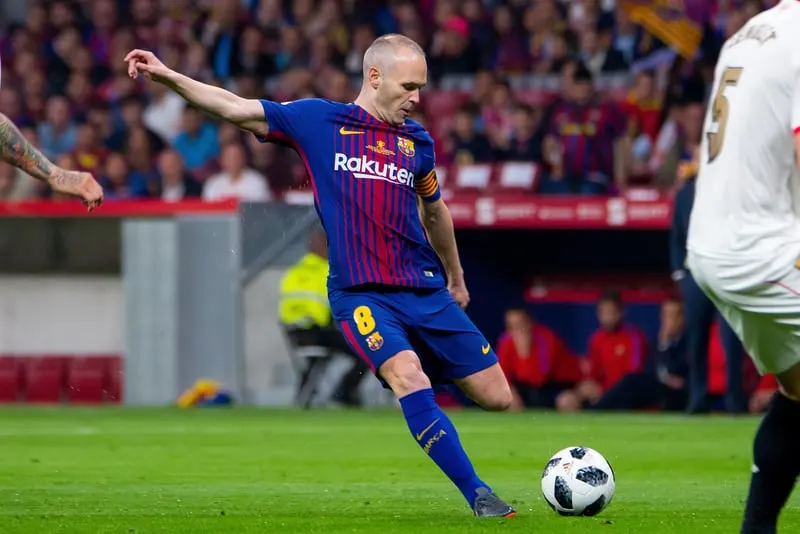
Assist In Soccer: An Overview
Something that professional and amateur soccer players alike know: it isn’t just about the goal. The player who gets the assist is critical to the point, as well.
But, what is an assist and how does it work? We’ll go through everything you need to know in this article.
What is an assist in soccer? An assist in soccer is when a player helps to score a goal by passing the ball to the goal scorer. Although not technically considered in the Laws of the Game, at the 1986 FIFA World Cup, the assist statistic was measured for the first time.
A New Statistic
For as long as soccer has been played in an organized manner, teams and fans have been keeping track of all sorts of things. For instance, there is a listing of all of the goals in the first FIFA World Cup—which took place in 1930.
From there, it took 56 years for anyone to start even looking at the player who had the ball before the goal scorer. But, of course, it was FIFA who began to track these playmakers.
Soccer Assist: The Definition and its Nuances
What counts as an assist in soccer is very simple: A player who passes the ball to a teammate in a way that leads to a goal, is awarded an assist. It doesn’t matter if the goalkeeper passes a defender and he manages to dribble past the whole team and scores, the goalkeeper will still be rewarded with an assist.
An assist simply means they were “assisting” another player to score. However, it’s only counted when a pass is made. Blocking defenders or other things that might be the reason why a player was able to score, won’t count as an assist.
This also means that assists are not counted in all goals. If a player scores without receiving the ball from a teammate, an assist won’t be counted. A soccer game that ends 3-3 might not include 6 assists, it could actually be 0 assists in that game.
FIFA World Cup Criteria
FIFA’s Technical Study Group developed the first criteria to determine what counts as an assist.
The first criteria for what counted as an assist included six key points:
- An assist is awarded to the player who passed the ball to the goal scorer.
- In some cases, assists can be given to the passer and the penultimate passer (second assist).
- In goals from a ball rebounding off the crossbar, the player who made the original shot on target was awarded an assist.
- In goals scored from penalty kicks, the fouled player received credit for the point. (This was changed in the 1990 World Cup so that the fouled player receives credit for an assist only).
- If a goal scorer scored without receiving the ball as a pass from a teammate, no assist is awarded.
- If the goal scorer takes advantage of a missed pass from an opponent, no assist is awarded.
In the 1994 World Cup, assists were used to help determine the tiebreaker for the Golden Boot award between Hristo Stoichkov and Oleg Salenko.
Limitations to the Assist
From the moment the passer releases the ball to the eventual goal scorer, it doesn’t matter how much time elapses between the pass and the goal. This gives the goal scorer time to get into the proper position and make the goal.
Also, if the player who receives the ball dribbles the ball through defenders, this still retains the assist. It is not a requirement that the passer passes the ball and the receiver immediately puts their foot on it and kicks it for a goal. The receiver is allowed to control the ball through whatever means necessary before making the score.
How Different Leagues Awards Assists

In France’s Ligue 1, there has been a trophy awarded to the player with the most decisive passes in a season. This Trophee de Meilleur Passeur has been awarded since the 2007-08 season.
The UK’s Premier League has factored in assists as part of the Actim Index of player performance since 2006-07. In 2018, the Premier League Playmaker of the Season award was created and given to the player with the most assists.
The name of the Premier League and Ligue 1 trophies highlight how important an assist is, as it equates the person who gets the assist to the person who makes the play.
On the other side of the Atlantic, North American sports like ice hockey and basketball already tracked assists, so when North American soccer leagues began, they did, as well. In addition, the college ruling board (the NCAA) tracks assist statistics for male and female soccer players among their various divisions.
Although there isn’t a specific trophy given out, in the 2021 season, Carli Lloyd of the US Women’s National Team had the most assists of the season with six.
Leaders in Assists
As most leagues and tournaments do track assists these days, even if they’re not all adhering to the exact same standards, sports fans do have some idea about who has the most assists to their name.
The 5 players with the most soccer assists in history:
| Player | Assists (Career) |
|---|---|
| 1. Lionel Messi | 358 |
| 2. Luis Suarez | 277 |
| 3. Cristiano Ronaldo | 272 |
| 4. Thomas Müller | 269 |
| 5. Angel Di Maria | 261 |
The most assists ever in a World Cup is, not surprisingly, Pele. In a single World Cup, he had a record nine assists.
Players with the most soccer assists in the FIFA World Cup :
| Player | Assists (World Cup) |
|---|---|
| 1. Pele | 10 |
| 2. Lionel Messi | 6 |
| 3. James Rodriquez | 5 |
| 4. Juan Cuadrado | 5 |
| 5. Thomas Muller | 4 |
Over the course of his career, Cristiano Ronaldo has had 42 assists in his games played in the UEFA Champions League.
Players with the most assists in the Champions League:
| Player | Assists (Champions League) |
|---|---|
| 1. Cristiano Ronaldo | 42 |
| 2. Lionel Messi | 36 |
| 3. Angel Di Maria | 34 |
| 4. Ryan Giggs | 31 |
| 5. Xavi | 30 |
In the Premier League, Manchester United player Ryan Giggs has the most career assists in PL games with 162.
Players with the most assists in the Premier League:
| Player | Assists (Premier League) |
|---|---|
| 1. Ryan Giggs | 162 |
| 2. Cesc Fabregas | 111 |
| 3. Wayne Rooney | 103 |
| 4. Frank Lampard | 102 |
| 5. Dennis Bergkamp | 94 |
Assists and Fantasy Sports
There is no question that the rise of virtual fantasy leagues has changed sports as we know them. Fans interact with the game in a whole new way, and fantasy leagues rely heavily on player statistics.
The official Fantasy Premier League rules relaxed the standards for what counts as an assist within their program. Mostly, inadvertent touches by opponents do not automatically discount the assist if the ball still reaches the intended target.
When considering a ball that is headed or bounced off of the chest, the player who heads the ball may still receive the assist if a goal is scored after the player heads it into the general area of the goalscorer instead of directly passing it to the goal scorer.
Goalies and Assists
Even though they hold a unique position on the team that might seem to exclude them from this particular statistic, goalies are able to get assists, as well. It is rarer, but if a goalie kicks a long pass to a teammate who then scores, then the goalie gets an assist.
This usually happens later in the game when the defenses are fatigued. Paul Robinson, a former goalie for a variety of clubs in the Premier League, holds the PL record of five career goalie assists.
Goalkeepers With The Most Assists:
| Goalkeeper | Assists |
|---|---|
| Paul Robinson | 5 |
| Pepe Reina | 4 |
| David Seaman | 4 |
| Tim Howard | 3 |
| Peter Schmeichel | 3 |
Assists and Egos

Within the world of professional soccer, there are certainly players who struggle to make assists. This isn’t because they’re technically incapable of making the pass, but rather because they want to get the point directly.
However, some of the best players in the world know that the game depends on all of the players coming together in order to get the goals.
Across multiple European leagues, several players have achieved what is sometimes called a double-double, meaning that they have double digit goals and assists in a single season.
The following players scored the highest numbers of double-doubles in 2020. This feat is all the more remarkable due to the shortened playing time of many leagues due to COVID-19.
- Lionel Messi of Barcelona scored 25 goals and 21 assists, the most of any European in any league.
- Mohamed Salah of Liverpool scored 19 goals and 10 assists while playing in the Premeir League.
- Domenico Berardi of the Italian team Sassuolo scored 14 goals and 10 assists.
These players, along with the players mentioned above, are among some of the best in the world. The correlation between great players having high levels of both goals and assists speaks to the way those players can set their egos aside.
Practicing Assists
Although soccer doesn’t have structured plays in the same way that American football does, teams do practice for scenarios that they can then implement on the field. By positioning themselves in relation to the ball, the strikers and midfielders can set themselves up to assist and score.
Some drills are focused on teaching players to continue attacking when the ball is heading towards the goal. Others help players practice situational awareness on the field.
Teams may also choose to implement these plays strategically. By drawing the defense towards a player who usually makes a scoring play and then having that player pass the ball, that can leave the receiving player open to score.
Although every team will have stronger and weaker players, the fact is that soccer is a team sport that relies on a team playing together with a common goal.
The increased interest in tracking assists shows that the game is much more than just the person who puts their boot to the ball and gets it into the back of the net.
